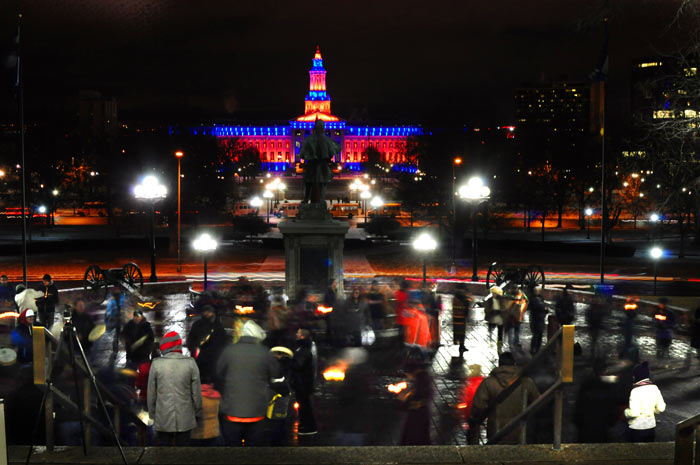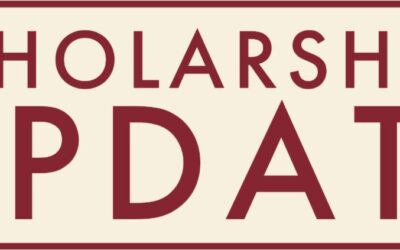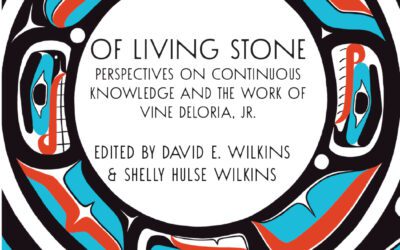
A group gathers for a round dance at the Colorado State Capitol on a cold Friday evening on Jan. 11, 2013.
Like many Natives and our allies across our Grandmother Earth, Unci Maka, I have joined the Idle No More movement, attending round dance gatherings, praying for Chief Theresa Spence and her supporters, sharing the stories I hear and read and perusing news and opinion pieces. Like many indigenous people, I am acutely aware that our voices in the mainstream of American, Canadian and Central and South American societies are often unheard, and that we appear silent when in fact our voices are singing out with stories of our lives. Defining this movement is our responsibility. Each of us should learn about this movement and find our own place in it. We can add our voices to songs of our relatives and allies across the earth.
The new calendar year can be a time of renewal and re-commitment for many – but for most Native people, our annual calendar is seasonal or ceremonial, related to the changes of our Grandmother Earth or the rituals of our people. For me the year goes from summer to summer, from the time of sun dances to the next sun dances. I know that measuring time in this manner comes from my identity. We may adopt the calendar year and New Year celebrations, but we find our renewal as tribal people in the seasons and rituals of our people.
As the Idle No More movement has gained strength, like many, I have pondered its meaning. For me, it is our voices, singing out from the place inside of us where our identities as “the people” live, it is the rhythm of our shared heartbeat and the movements of our bodies as we dance a shared dance – a social dance of hope and friendship and affirmation, in a circle, around the drums and the voices that are singing out who we are.
Each tribal people have a unique identity given us by our Creator and our understanding of Creation. Our identity emerges out of our knowledge of how we came to be as a people. Our oral knowledge is intact and the stories of our creation remain essentially untainted by western influences. Often we are viewed by mainstream America in the context of what educators call the three F’s – food, fun, and fashion. We are the celebration of Thanksgiving, the Indians in popular movies, feathered headdresses, geometric designed pottery, and lilting flute music. A deeper understanding of who we are, philosophically, spiritually, and socially is elusive to most of mainstream America. I often think this elusiveness is exacerbated by the fact that it would require a painful acknowledgement that we, as the First Peoples of this hemisphere, are really human beings subjected to devastating military and political policies of the very governments that still lead our countries.
Tribal people have their own teachings about their Creation, their family relationships, and how they came to be on this earth. Native people have teachings about plants and animals, about gathering in celebration, and about the meaning of each item of decoration or clothing that they wear at their ceremonies.
Our stories reflect the richness of our heritages which are such an important part of today’s democracy. Although the experiences of Native people with the arrival of Europeans on our shores are filled with tragedy, we have not lost our identity or cultural ways. Idle No More is the story of our shared identity. Like all social movements, it has roots in history and connections with the social actions of other movements, including the Occupy movement and environmental actions.
Tribally controlled education is a vital part of the foundation of tribal knowledge that underpins the Idle No More movement. In today’s society the education of our people is essential to our prosperity, our identity, and our activism. The tribally controlled education movement emerged during the last modern great wave of social activism among our people–the American Indian Movement in the late 1960s. In the last 45 years, tribal educators and our schools and colleges have been at the forefront of the restoration and preservation of our identities. Our work ensures that our ancestors and descendants will recognize us.
Now is the time to affirm that we are entitled to an education that honors our identity, our knowledge of Creation, and our relationships. We are entitled to the best of public education – a tribally controlled education – that culls content from our knowledge with teaching methodologies and assessment that uphold our ways of learning.
As our social activism grows, look to our Native educators and encourage them to bring Idle No More into their classrooms. It is a modern-day teachable moment in the context of our cultural ways and the histories of our people. It is a moment that can last a lifetime. It is the work of a lifetime that will be felt for seven generations.
Dr. Cheryl Crazy Bull is President and CEO of the American Indian College Fund.






